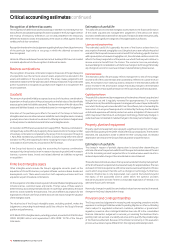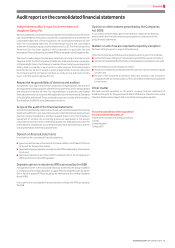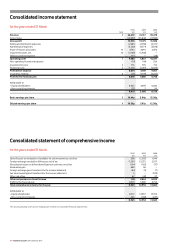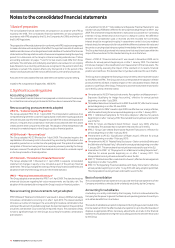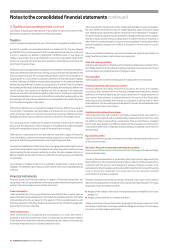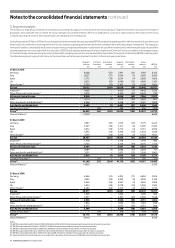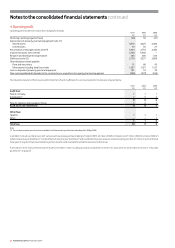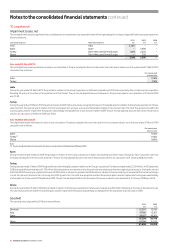Vodafone 2010 Annual Report Download - page 84
Download and view the complete annual report
Please find page 84 of the 2010 Vodafone annual report below. You can navigate through the pages in the report by either clicking on the pages listed below, or by using the keyword search tool below to find specific information within the annual report.
82 Vodafone Group Plc Annual Report 2010
Notes to the consolidated nancial statements continued
Other investments classified as held for trading and available-for-sale are stated at
fair value. Where securities are held for trading purposes, gains and losses arising
from changes in fair value are included in net profit or loss for the period. For available-
for-sale investments, gains and losses arising from changes in fair value are recognised
directly in equity, until the security is disposed of or is determined to be impaired, at
which time the cumulative gain or loss previously recognised in equity, determined
using the weighted average cost method, is included in the net profit or loss for
the period.
Other investments classified as loans and receivables are stated at amortised cost
using the effective interest method, less any impairment.
Cash and cash equivalents
Cash and cash equivalents comprise cash on hand and call deposits, and other short-
term highly liquid investments that are readily convertible to a known amount of cash
and are subject to an insignificant risk of changes in value.
Trade payables
Trade payables are not interest bearing and are stated at their nominal value.
Financial liabilities and equity instruments
Financial liabilities and equity instruments issued by the Group are classified
according to the substance of the contractual arrangements entered into and the
definitions of a financial liability and an equity instrument. An equity instrument is
any contract that evidences a residual interest in the assets of the Group after
deducting all of its liabilities and includes no obligation to deliver cash or other
financial assets. The accounting policies adopted for specific financial liabilities and
equity instruments are set out below.
Capital market and bank borrowings
Interest bearing loans and overdrafts are initially measured at fair value (which is
equal to cost at inception), and are subsequently measured at amortised cost, using
the effective interest rate method, except where they are identified as a hedged
item in a fair value hedge. Any difference between the proceeds net of transaction
costs and the settlement or redemption of borrowings is recognised over the term of
the borrowing.
Equity instruments
Equity instruments issued by the Group are recorded at the proceeds received, net
of direct issuance costs.
Derivative financial instruments and hedge accounting
The Group’s activities expose it to the financial risks of changes in foreign exchange
rates and interest rates.
The use of financial derivatives is governed by the Group’s policies approved by the
Board of directors, which provide written principles on the use of financial derivatives
consistent with the Group’s risk management strategy. Changes in values of all
derivatives of a financing nature are included within investment income and financing
costs in the income statement. The Group does not use derivative financial
instruments for speculative purposes.
Derivative financial instruments are initially measured at fair value on the contract
date and are subsequently remeasured to fair value at each reporting date. The Group
designates certain derivatives as either:
hedges of the change of fair value of recognised assets and liabilities (‘fair value
hedges’); or
hedges of net investments in foreign operations.
Hedge accounting is discontinued when the hedging instrument expires or is sold,
terminated, or exercised, or no longer qualifies for hedge accounting, or the Company
chooses to end the hedging relationship.
2. Signicant accounting policies continued
Cumulative actuarial gains and losses at 1 April 2004, the date of transition to IFRS,
have been recognised in the statement of financial position.
Taxation
Income tax expense represents the sum of the current tax payable and deferred tax.
Current tax payable or recoverable is based on taxable profit for the year. Taxable
profit differs from profit as reported in the income statement because some items of
income or expense are taxable or deductible in different years or may never be
taxable or deductible. The Group’s liability for current tax is calculated using UK and
foreign tax rates and laws that have been enacted or substantively enacted by the
end of reporting period date.
Deferred tax is the tax expected to be payable or recoverable in the future arising from
temporary differences between the carrying amounts of assets and liabilities in the
financial statements and the corresponding tax bases used in the computation of
taxable profit. It is accounted for using the statement of financial position liability
method. Deferred tax liabilities are generally recognised for all taxable temporary
differences and deferred tax assets are recognised to the extent that it is probable
that taxable profits will be available against which deductible temporary differences
can be utilised. Such assets and liabilities are not recognised if the temporary
difference arises from the initial recognition (other than in a business combination)
of assets and liabilities in a transaction that affects neither the taxable profit nor the
accounting profit. Deferred tax liabilities are not recognised to the extent they arise
from the initial recognition of goodwill.
Deferred tax liabilities are recognised for taxable temporary differences arising on
investments in subsidiaries and associates, and interests in joint ventures, except
where the Group is able to control the reversal of the temporary difference and it is
probable that the temporary difference will not reverse in the foreseeable future.
The carrying amount of deferred tax assets is reviewed at each end of reporting
period date and adjusted to reflect changes in probability that sufficient taxable
profits will be available to allow all or part of the asset to be recovered.
Deferred tax is calculated at the tax rates that are expected to apply in the period
when the liability is settled or the asset realised, based on tax rates that have been
enacted or substantively enacted by the end of reporting period date.
Tax assets and liabilities are offset when there is a legally enforceable right to set off
current tax assets against current tax liabilities and when they either relate to income
taxes levied by the same taxation authority on either the same taxable entity or on
different taxable entities which intend to settle the current tax assets and liabilities
on a net basis.
Tax is charged or credited to the income statement, except when it relates to items
charged or credited directly to equity, in which case the tax is also recognised directly
in equity.
Financial instruments
Financial assets and financial liabilities, in respect of financial instruments, are
recognised on the Group’s statement of financial position when the Group becomes
a party to the contractual provisions of the instrument.
Trade receivables
Trade receivables do not carry any interest and are stated at their nominal value as
reduced by appropriate allowances for estimated irrecoverable amounts. Estimated
irrecoverable amounts are based on the ageing of the receivable balances and
historical experience. Individual trade receivables are written off when management
deems them not to be collectible.
Other investments
Other investments are recognised and derecognised on a trade date where a
purchase or sale of an investment is under a contract whose terms require delivery
of the investment within the timeframe established by the market concerned, and
are initially measured at cost, including transaction costs.


